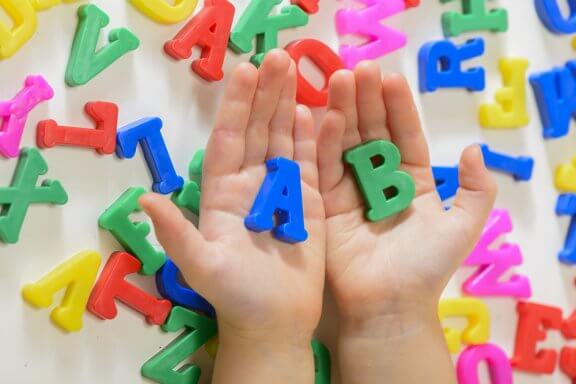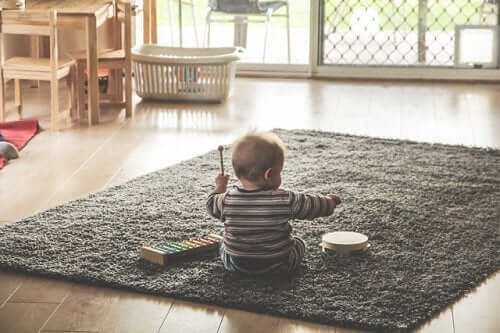Teaching Pattern Recognition to Your Child: 5 Fun Activities


Written and verified by the psychologist Maria Fátima Seppi Vinuales
Pattern recognition is a fundamental cognitive skill that can help children develop logical thinking and problem-solving skills. By teaching your child to recognize patterns, you’re providing them with a valuable tool for understanding the world around them and fostering their ability to predict, analyze, and classify information.
But does teaching patterns to your child sound repetitive, monotonous, and a bit boring? On the contrary! It’s the key to accessing a world of varied knowledge and learning to organize, recognize, and identify elements.
In addition, while it’s the basis for logical mathematical thinking, it also has a direct link to art and music. Keep reading and you’ll understand the importance of having your child learn pattern recognition and some fun activities to help them do so.

Why is it important to teach patterns and series to children?
When we talk about series or patterns, we’re referring to identifying certain sequences or common characteristics. That is, it’s about being able to make your child understand that if they see an image with a circle-square-circle, then they can expect that another square will follow.
Some of the benefits of teaching your child to recognize patterns involve the development and exercise of the following skills.
The development of logical and mathematical thinking
Patterns serve as the basis for the development of mathematical skills. Initially, it’ll be basic, eventually becoming more complicated and allowing for more difficult operations such as multiplication.
Problem-solving
By recognizing patterns, children are also able to detect when something is “out of the ordinary” or different. Therefore, in an exercise, they can organize elements and letters to follow the course of the series. This way, they’re proactive in making decisions.
Organization
Patterns also allow some room for forethought and order. Therefore, by learning them, your child will be able to access information and organize it according to their goal.
The development of other skills and types of thinking
For example, those linked to artistic skills. Series and sequences are also elements that are used as visual resources in artistic creations.
Creativity
Far from what one may think, teaching pattern recognition to children allows them to understand a certain logic of operation, while helping them to think of different ways of solving, approaching, and arranging, among others.
Finally, logical-mathematical knowledge has great value, as it’s not reduced only to these types of operations, but, on the contrary, it exceeds this area. Beyond counting objects or being able to identify how a series follows, it contributes to a person’s ability to think about all kinds of situations.
You may be interested in: Divergent and Convergent Thinking: How to Stimulate Them
How to teach patterns and series to your child?
Pattern recognition starts from smallest to largest, taking into account your child’s age and development. For example, you can first think of sizes (big and small) and objects according to their use (objects used for eating and others used for cleaning), among others. In other words, you start with the AB pattern. An example would be apple-pear.
Here are some practical exercises and activities to keep in mind to stimulate thinking.
1. Complete the series through magnetized figures
Either on a blackboard or on the refrigerator door, you can ask your child to identify the missing shape. For example, “circle-cross-circle-circle-which one is next?” Or, you can draw a complete line and leave an empty space, asking your child to tell you what the missing shape is.
2. Use LEGOS
These toys are known for having pieces of different colors, sizes, and shapes. So, if they’re one of your child’s favorites, you can use them to introduce some pattern ideas. For example, green rectangle, yellow rectangle.
You can also use stickers following the same logic as suggested above, but changing the format. This can be an interesting variation that will keep your child from getting bored of the same game every time.
3. Make bracelets, necklaces, or key chains
Practice patterns through crafts. You can use either noodles of different shapes or beads. Also, you can do it with a specific color sequence or even with letters to teach your child to spell their name. The possibilities are endless!

4. Create musical and rhythmic patterns!
For example, clap your hands on the table, double clap your hands on the table, clap your hands together, etc. This could become your child’s favorite activity while stimulating their cognitive and emotional development.
5. Make a sequence with playdough
You can do this with colored play dough or by creating play dough shapes. For example, a little ball and an “elongated snake”. Here, you won’t only be teaching your child patterns, you’ll also stimulate the development of their motor skills.
Recommendations for teaching pattern recognition to your child
Beyond the suggested activities, it’s important that you can choose objects that are appropriate for your child’s age, both in weight and size. This way, they’ll be able to manipulate them as they wish. They can be either their toys or household objects (for example, a plate and a cup on it).
It’s also advisable that, in the beginning, you can work with elements that are familiar to them. For example, if they already know some geometric shapes, work the patterns from there as a starting point. This way, learning focuses on “the pattern” and not on learning the name of a new object.
Finally, as patterns appear in many everyday situations, you can take advantage of any scenario to practice them.
You may be interested in: 12 Activities with Music and Rhythm to Stimulate Creativity in Children
Every game has an objective
Every teaching moment – whether informal, like at home, or formal, like school – has its own knowledge objectives. However, sometimes people aren’t fully aware of what different knowledge implies and how important it is to stimulate different types of thinking.
Play is the main way children learn. Therefore, today’s knowledge, perhaps disguised as a playful activity, is the seed of deeper and more complex knowledge tomorrow, hence the importance of offering diversity in the teaching-learning process, especially at an early age.
Sometimes, learning and practicing mathematics – with the identification of patterns as a necessary prelude – becomes tedious. However, it’s a matter of making certain exercises and teachings accessible so as not to discourage or bore your child.
Pattern recognition is a fundamental cognitive skill that can help children develop logical thinking and problem-solving skills. By teaching your child to recognize patterns, you’re providing them with a valuable tool for understanding the world around them and fostering their ability to predict, analyze, and classify information.
But does teaching patterns to your child sound repetitive, monotonous, and a bit boring? On the contrary! It’s the key to accessing a world of varied knowledge and learning to organize, recognize, and identify elements.
In addition, while it’s the basis for logical mathematical thinking, it also has a direct link to art and music. Keep reading and you’ll understand the importance of having your child learn pattern recognition and some fun activities to help them do so.

Why is it important to teach patterns and series to children?
When we talk about series or patterns, we’re referring to identifying certain sequences or common characteristics. That is, it’s about being able to make your child understand that if they see an image with a circle-square-circle, then they can expect that another square will follow.
Some of the benefits of teaching your child to recognize patterns involve the development and exercise of the following skills.
The development of logical and mathematical thinking
Patterns serve as the basis for the development of mathematical skills. Initially, it’ll be basic, eventually becoming more complicated and allowing for more difficult operations such as multiplication.
Problem-solving
By recognizing patterns, children are also able to detect when something is “out of the ordinary” or different. Therefore, in an exercise, they can organize elements and letters to follow the course of the series. This way, they’re proactive in making decisions.
Organization
Patterns also allow some room for forethought and order. Therefore, by learning them, your child will be able to access information and organize it according to their goal.
The development of other skills and types of thinking
For example, those linked to artistic skills. Series and sequences are also elements that are used as visual resources in artistic creations.
Creativity
Far from what one may think, teaching pattern recognition to children allows them to understand a certain logic of operation, while helping them to think of different ways of solving, approaching, and arranging, among others.
Finally, logical-mathematical knowledge has great value, as it’s not reduced only to these types of operations, but, on the contrary, it exceeds this area. Beyond counting objects or being able to identify how a series follows, it contributes to a person’s ability to think about all kinds of situations.
You may be interested in: Divergent and Convergent Thinking: How to Stimulate Them
How to teach patterns and series to your child?
Pattern recognition starts from smallest to largest, taking into account your child’s age and development. For example, you can first think of sizes (big and small) and objects according to their use (objects used for eating and others used for cleaning), among others. In other words, you start with the AB pattern. An example would be apple-pear.
Here are some practical exercises and activities to keep in mind to stimulate thinking.
1. Complete the series through magnetized figures
Either on a blackboard or on the refrigerator door, you can ask your child to identify the missing shape. For example, “circle-cross-circle-circle-which one is next?” Or, you can draw a complete line and leave an empty space, asking your child to tell you what the missing shape is.
2. Use LEGOS
These toys are known for having pieces of different colors, sizes, and shapes. So, if they’re one of your child’s favorites, you can use them to introduce some pattern ideas. For example, green rectangle, yellow rectangle.
You can also use stickers following the same logic as suggested above, but changing the format. This can be an interesting variation that will keep your child from getting bored of the same game every time.
3. Make bracelets, necklaces, or key chains
Practice patterns through crafts. You can use either noodles of different shapes or beads. Also, you can do it with a specific color sequence or even with letters to teach your child to spell their name. The possibilities are endless!

4. Create musical and rhythmic patterns!
For example, clap your hands on the table, double clap your hands on the table, clap your hands together, etc. This could become your child’s favorite activity while stimulating their cognitive and emotional development.
5. Make a sequence with playdough
You can do this with colored play dough or by creating play dough shapes. For example, a little ball and an “elongated snake”. Here, you won’t only be teaching your child patterns, you’ll also stimulate the development of their motor skills.
Recommendations for teaching pattern recognition to your child
Beyond the suggested activities, it’s important that you can choose objects that are appropriate for your child’s age, both in weight and size. This way, they’ll be able to manipulate them as they wish. They can be either their toys or household objects (for example, a plate and a cup on it).
It’s also advisable that, in the beginning, you can work with elements that are familiar to them. For example, if they already know some geometric shapes, work the patterns from there as a starting point. This way, learning focuses on “the pattern” and not on learning the name of a new object.
Finally, as patterns appear in many everyday situations, you can take advantage of any scenario to practice them.
You may be interested in: 12 Activities with Music and Rhythm to Stimulate Creativity in Children
Every game has an objective
Every teaching moment – whether informal, like at home, or formal, like school – has its own knowledge objectives. However, sometimes people aren’t fully aware of what different knowledge implies and how important it is to stimulate different types of thinking.
Play is the main way children learn. Therefore, today’s knowledge, perhaps disguised as a playful activity, is the seed of deeper and more complex knowledge tomorrow, hence the importance of offering diversity in the teaching-learning process, especially at an early age.
Sometimes, learning and practicing mathematics – with the identification of patterns as a necessary prelude – becomes tedious. However, it’s a matter of making certain exercises and teachings accessible so as not to discourage or bore your child.
All cited sources were thoroughly reviewed by our team to ensure their quality, reliability, currency, and validity. The bibliography of this article was considered reliable and of academic or scientific accuracy.
- Celi Rojas, Sonia Zhadira, Sánchez, Viviana Catherine, Quilca Terán, María Soledad, & Paladines Benítez, María del Carmen. (2021). Estrategias didácticas para el desarrollo del pensamiento lógico matemático en niños de educación inicial. Horizontes Revista de Investigación en Ciencias de la Educación, 5(19), 826-842. Epub 30 de septiembre de 2021.https://doi.org/10.33996/revistahorizontes.v5i19.240
- Lugo, J. K., Vilchez, O., & Romero, L. J. (2019). Didáctica y desarrollo del pensamiento lógico matemático. Un abordaje hermenéutico desde el escenario de la educación inicial. Revista Logos Ciencia & Tecnología, 11(3), 18-29. http://dx.doi.org/10.22335/rlct.vlli3.991
- Mujica-Stach, Ana Milena, & Márquez Torres, Maximina. (2022). Pensamiento matemático en la primera infancia: estrategias de enseñanza de las educadoras de párvulos. Mendive. Revista de Educación, 20(4), 1338-1352. Epub 02 de diciembre de 2022. Recuperado en 28 de mayo de 2023, de http://scielo.sld.cu/scielo.php?script=sci_arttext&pid=S1815-76962022000401338&lng=es&tlng=es.
This text is provided for informational purposes only and does not replace consultation with a professional. If in doubt, consult your specialist.








